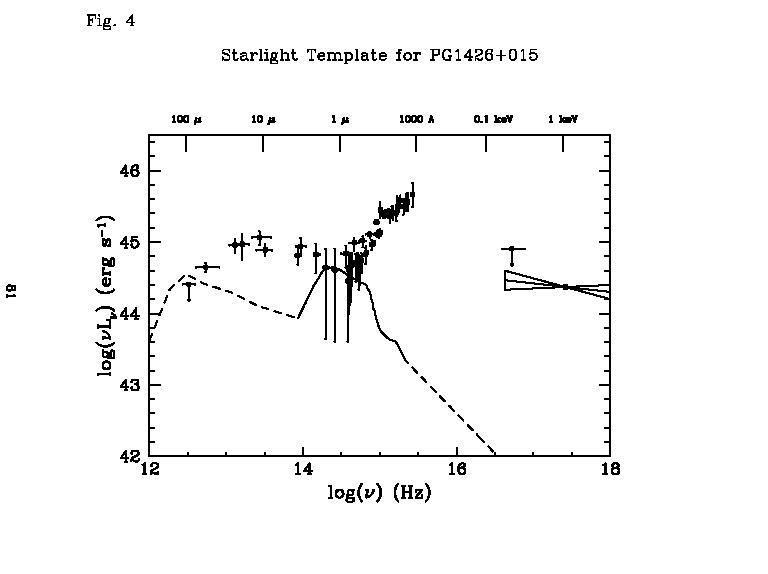
The starlight correction is largest near 1 micron, and is small even there for the higher luminosity objects. For the lower luminosity objects, we normalized the starlight component based on published measurements of the host galaxy luminosity where available (rather than fitting the normalization to a multicomponent model of the SED itself as is normally done these days).
The individual quasar SEDs were composed of photometry and spectrophotometry taken in a variety of apertures. A simple spatial model of the host galaxy was used, based on reported half-light radii for each object. Our modified Hubble law is
S(r) = S0 / ( 1 + r/(g*re))^2
with a cutoff at r/re = 5.4. The parameter g is set to 0.093, and re is the half-light radius.Fig 4. Starlight template used for host galaxy subtraction. Template is shown with energy distribution of PG 1426+015 for comparison, with relative normalization appropriate for the limit of large aperture. Dashed lines illustrate mean IR and X-ray colors of galaxy, not used in subtraction.
Fig 5. Adopted host galaxy luminosities and radii. The solid curve indicates the Bingelli et al (1984) relation. Points marked by open circles are constrained to lie on the curve, while radii for other points are derived using radial profile information as described in the text. The median host galaxy normalization used where specific information is lacking is indicated by the large solid symbol and represents the median of the other points. The well known galaxies M31 and M87 are also plotted on the figure for comparison.
Fig. 6 Host galaxy flux corrections at rest frame H (percent) as a function of absolute visual magnitude. Solid circles indicate corrections made using data on the specific host galaxy, while open circles indicate use of the median normalization. Note that as you move away from the H (1 micron-ish) spectral region the magnitude of the correction quickly becomes much smaller.
| Object | Log L(H)(erg/s) | Re (kpc) | Ref |
|---|---|---|---|
| Q0003+158 | 44.60+- 0.30, 0.60 | 10.00 | 0 |
| Q0007+106 | 44.43+- 0.08, 0.05 | 7.00 | 1 |
| Q0026+129 | 44.30+- 0.03, 0.02 | 5.76 | 6 |
| Q0049+171 | 43.60+- 0.04, 0.04 | 4.34 | 3 |
| Q0050+124 | 44.62+- 0.04, 0.04 | 7.68 | 3 |
| Q0052+251 | 44.78+- 0.09, 0.05 | 12.61 | 1 |
| Q0054+144 | 44.71+- 0.04, 0.04 | 12.44 | 2 |
| Q0121-590 | 44.90+- 0.04, 0.04 | 11.53 | 9 |
| Q0134+329 | 45.44+- 0.04, 0.04 | 9.24 | 2 |
| Q0205+024 | 44.19+- 0.04, 0.04 | 0.19 | 3 |
| Q0312-770 | 44.60+- 0.30, 0.60 | 10.00 | 0 |
| Q0637-752 | 44.60+- 0.30, 0.60 | 10.00 | 0 |
| Q0804+761 | 44.60+- 0.30, 0.60 | 10.00 | 0 |
| Q0837-120 | 44.60+- 0.30, 0.60 | 10.00 | 0 |
| Q0844+349 | 44.60+- 0.25, 0.60 | 10.00 | 0 |
| Q1028+313 | 44.60+- 0.30, 0.60 | 10.00 | 0 |
| Q1100+772 | 44.49+- 0.03, 0.01 | 11.05 | 4 |
| Q1116+215 | 44.74+- 0.04, 0.03 | 13.76 | 5 |
| Q1137+660 | 44.60+- 0.30, 0.60 | 10.00 | 0 |
| Q1146-037 | 44.60+- 0.25, 0.60 | 10.00 | 0 |
| Q1202+281 | 44.71+- 0.03, 0.02 | 12.02 | 5 |
| Q1211+143 | 43.39+- 0.00, 0.04 | 1.95 | 6 |
| Q1219+755 | 44.60+- 0.11, 0.60 | 10.00 | 0 |
| Q1226+023 | 44.79+- 0.03, 0.01 | 9.67 | 4 |
| Q1307+085 | 44.60+- 0.30, 0.60 | 10.00 | 0 |
| Q1352+183 | 44.21+- 0.04, 0.04 | 6.78 | 8 |
| Q1407+265 | 44.60+- 0.30, 0.60 | 10.00 | 0 |
| Q1416-129 | 44.60+- 0.15, 0.60 | 10.00 | 0 |
| Q1426+015 | 44.60+- 0.30, 0.60 | 10.00 | 0 |
| Q1501+106 | 44.09+- 0.04, 0.03 | 4.07 | 6 |
| Q1545+210 | 44.90+- 0.04, 0.03 | 16.38 | 6 |
| Q1613+658 | 44.89+- 0.04, 0.04 | 13.04 | 7 |
| Q1704+608 | 44.60+- 0.03, 0.02 | 9.69 | 6 |
| Q1721+343 | 44.60+- 0.30, 0.60 | 10.00 | 0 |
| Q1803+676 | 43.38+- 0.04, 0.04 | 3.24 | 8 |
| Q2130+099 | 44.42+- 0.04, 0.04 | 4.64 | 2 |
| Q2135-147 | 44.89+- 0.04, 0.04 | 14.36 | 3 |
Objects with no spatial information (ref 0) have been assigned the median host galaxy luminosity of the remainder of the sample. References for host galaxy information:
(0) No data, median value assigned (1) Boroson, Oke and Green (1982); (2) Gehren et al (1984); (3) Smith et al (1986); (4) Boroson and Oke (1984); %(5) Boroson, Persson and Oke (1985); (5) McAlary et al (1983); (6) Neugebauer et al (1985); (7) Yee and Green (1987); (8) Hutchings, Crampton and Campbell (1984); (9) Griersmith and Visvanathan (1979). (10) Hutchings, Johnson and Pike (1988); (11) Hutchings, Janson and Neff (1989) (12) Neizvestnii (1986); (13) MacKenty (1990).